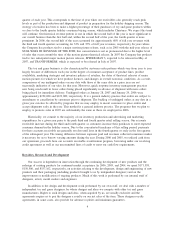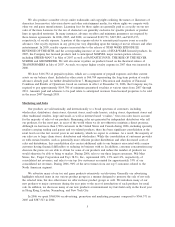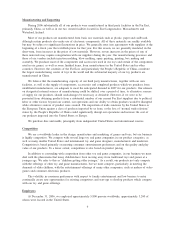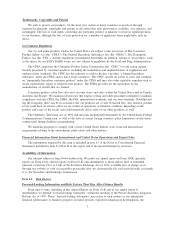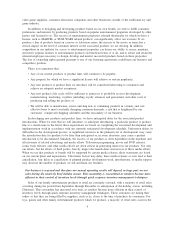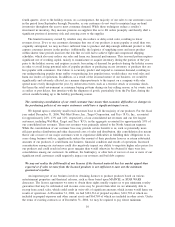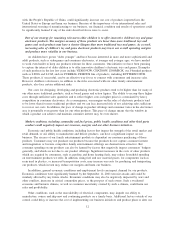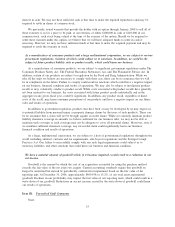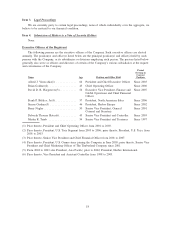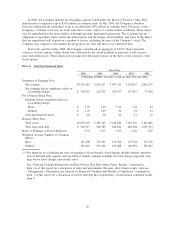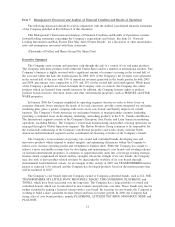Hasbro 2006 Annual Report Download - page 24
Download and view the complete annual report
Please find page 24 of the 2006 Hasbro annual report below. You can navigate through the pages in the report by either clicking on the pages listed below, or by using the keyword search tool below to find specific information within the annual report.actions and reduce actual results. For example, work stoppages, slowdowns or strikes, a severe public health
pandemic or the occurrence or threat of wars or other conflicts, could impact our ability to manufacture or
deliver product, resulting in increased costs and/or lost sales for our products.
Our business is dependent on intellectual property rights and we may not be able to protect such rights
successfully. In addition, we have a material amount of acquired product rights which, if impaired, would
result in a reduction of our income.
Our intellectual property, including our license agreements and other agreements that establish our
ownership rights and maintain the confidentiality of our intellectual property, are of great value. We rely on a
combination of trade secret, copyright, trademark, patent and other proprietary rights laws to protect our rights
to valuable intellectual property related to our brands. From time to time, third parties have challenged, and
may in the future try to challenge, our ownership of our intellectual property. In addition, our business is
subject to the risk of third parties counterfeiting our products or infringing on our intellectual property rights.
We may need to resort to litigation to protect our intellectual property rights, which could result in substantial
costs and diversion of resources. Our failure to protect our intellectual property rights could harm our business
and competitive position. Much of our intellectual property has been internally developed and has no carrying
value on our balance sheet. However, as of December 31, 2006, we had approximately $532,257 of acquired
product and licensing rights included in other assets on our balance sheet. Declines in the profitability of the
acquired brands or licensed products may impact our ability to recover the carrying value of the related assets
and could result in an impairment charge. Reduction in our net income caused by impairment charges could
harm our financial results.
We may not realize the anticipated benefits of future acquisitions or those benefits may be delayed or
reduced in their realization.
Although we have not made any major acquisitions in the last few years, acquisitions have been a
significant part of our historical growth and have enabled us to further broaden and diversify our product
offerings. In making acquisitions, we target companies that we believe offer attractive family entertainment
products. We may also target companies in markets where we would like to increase our local presence.
However, we cannot be certain that the products of companies we may acquire in the future will achieve or
maintain popularity with consumers or that we will be successful in a particular geographic region. In some
cases, we expect that the integration of the product lines of the companies that we acquire into our operations
will create production, marketing and other operating synergies which will produce greater revenue growth
and profitability and, where applicable, cost savings, operating efficiencies and other advantages. However, we
cannot be certain that these synergies, efficiencies and cost savings will be realized. Even if achieved, these
benefits may be delayed or reduced in their realization. In other cases, we acquire companies that we believe
have strong and creative management, in which case we plan to operate them more autonomously rather than
fully integrating them into our operations. We cannot be certain that the key talented individuals at these
companies will continue to work for us after the acquisition or that they will continue to develop popular and
profitable products or services.
From time to time, we are involved in litigation, arbitration or regulatory matters where the outcome is
uncertain and which could entail significant expense.
As is the case with many large multinational corporations, we are subject from time to time to regulatory
investigations, litigation and arbitration disputes. Because the outcome of litigation, arbitration and regulatory
investigations is inherently difficult to predict, it is possible that the outcome of any of these matters could
entail significant expense for us and harm our business. The fact that we operate in significant numbers of
international markets also increases the risk that we may face legal and regulatory exposures as we attempt to
comply with a large number of varying legal and regulatory requirements.
13



